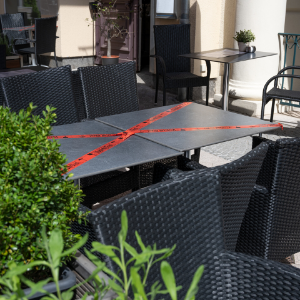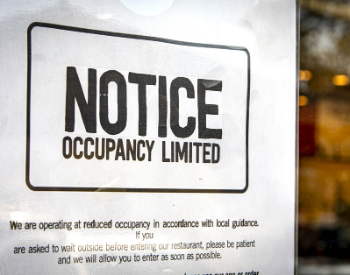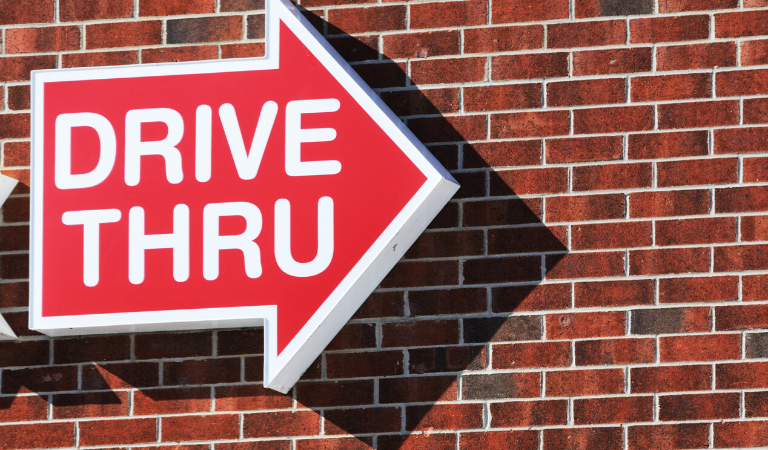Stats Of The Week
The State Of The Industry
With restaurants in every state starting to reopen, everyone is eager to see how consumers will respond to having the option of in-person dining. If all stay-at-home orders were lifted tomorrow, about 66% of consumers say they wouldn’t feel comfortable eating in a restaurant’s dining room, according to research from the Washington State University’s Carson College of Business. Only 21% of respondents say that they feel ready for in-person dining as soon as restrictions are lifted. 50% of consumers indicated that they would wait at least one to three months or more before dining in a restaurant.
Consumers Perspective On Social Distancing In Restaurants
According to research by Technomic, half of consumers would be comfortable dining in at restaurants with tables placed 6 feet apart. However, 27% feel most comfortable dining at least 9-15 feet apart from other tables. Their research reported that more than half of consumers would be willing to follow social distancing guidelines, but less than half would be willing to wear a mask or gloves while dining at a restaurant.
What’s Trending
NYC Mayor Signs Relief Bill For Restaurants
New York City Mayor Bill de Blasio signed seven pieces of legislation as part of a COVID-19 relief package that will provide assistance to restaurants during the coronavirus crisis. The relief package includes specific laws that help release some of the economic strain on restaurants throughout the declared emergency and up to 90 days after. Some of these laws include forbidding third-party food delivery services from charging restaurants a fee for telephone orders that don’t result in a sale and capping third-party commission fees at 15% per delivery or 5% per order for any other charge. With New York City restaurants losing roughly $2 billion in sales and 250,000 jobs in the month of March alone, many are hoping that these new laws can help alleviate some of the economic impacts coronavirus has had.
CDC Creates Guidelines For Restaurants
The Centers for Disease Control and Prevention (CDC) has released a flowchart outlining the steps restaurant and bar owners should take before reopening their establishments during the coronavirus pandemic. The first action operators should consider is whether reopening would be possible with their current state and local orders. They must also consider whether they are prepared enough to protect employees at a higher risk for severe illness. The CDC guidelines state if the answer to either of these questions is “no”, then owners should not reopen their businesses. Although the CDC and the White House have published documents for guidance and a three-phase reopening plan, the execution of these protocols are dependent on the decisions of state and local governments.
Restaurant Reservations Adjust To Reopenings
Popular reservation platforms, such as OpenTable and Resy, are expanding their services to include reserved seating for bars and wineries, virtual waitlists, and new capacity monitoring tools to ensure restaurants avoid overcrowding. These new waitlist features will allow guests to virtually add themselves to a restaurant’s waitlist if they’re in close proximity to the restaurant geographically. This will help prevent customers from crowding in waiting areas and helps customers maintain a safe distance from others. The capacity monitor lets restaurants set a specific capacity to adhere to local guidelines which allow for only 25% or 50% seating limits. This feature will automatically disable reservations once restaurants reach their capacity cap. By helping restaurants manage traffic flow and consumers adjust to the new normal, these platforms are evolving to meet the demands of post-pandemic operations.
DoorDash Adds A New Feature For Pickup Orders
DoorDash has recently launched a new feature in its app that will track a customer’s location so that restaurants will be notified when a customer arrives to pick up their order. This new feature is designed to make the pickup process easier for customers who beforehand had to opt-in to sharing their location and had to wait on the curb for their orders to be ready. In a DoorDash survey, they found that 44% of customers reported affordability as the top reason why they chose pickup over delivery with a majority of them stating that they prefer to pick up meals to save money and enjoy their food from the comfort of home. Live tracking customers gives restaurants more lead time to make sure orders are ready faster and allow customers to pick up their meals with more ease.
Starbucks Pivots To On-The-Go Customers
As a part of Starbucks’ COVID-19 plan, called “Bridge to the Future”, the popular coffee chain is accelerating its developments to cater to curbside pickup and delivery. The company reports they will be relocating stores in low-performing areas to locations where they can offer drive-thru. Starbucks has revised its pre-pandemic plan of building more drive-thrus in three to five years and is accelerating it to occur within the next 12 to 18 months. In more populated metropolitan cities, they are going to create pickup only locations.
"By augmenting the in-store experience with mobile ordering and contactless pickup, we can service
significant volumes of customers without having the café seating area actually opened," Kevin Johnson,
Starbucks CEO, said in an earnings call.
Bright Spots In A COVID-19 World
World Central Kitchen Pays Restaurants To Feed The Hungry
World Central Kitchen (WCK), founded by internationally-recognized Chef José Andrés, has launched a new program called “Restaurants for the People” which delivers food to those in need while simultaneously keeping restaurants open. WCK has promised to cover the costs of one million meals prepared by over 400 restaurants across the country. The nonprofit will reimburse restaurants at a rate of about $10 per meal and is also handling the delivery logistics. This program is designed to help businesses rehire employees while providing meals for those that need it the most.
Local Restaurant Makes An Exception For A Special Surprise
Souvla, a Greek fast-casual restaurant in San Francisco, has kept all of its locations closed during shelter-in-place orders. Sam Goldstein and Christa Simone had their first date at Souvla five years ago where Goldstein had been planning to surprise Simone with a public proposal. Once the pandemic caused the restaurant to close, Goldstein had to make different plans. He emailed the restaurant with a proposal plan and was met with owners that were happy to help. Charles Bililies, Souvla owner, opened the restaurant just for them and decorated the space with roses. Goldstein proposed and Simones said yes.
“We were blown away by how incredibly generous and helpful Charles and Jen were,” Goldstein told Eater. “It just goes to show how kind people can be, even to complete strangers. It was one of those moments that restore your faith in humanity.”
Quote Of Hope
"What I know is that America is an amazing country, and for me, America is people coming together to help each other. Let's be more kind. Let's be more conscious. Let's be more helpful. That’s what I hope is going to happen." - Dominique Crenn, Chef






